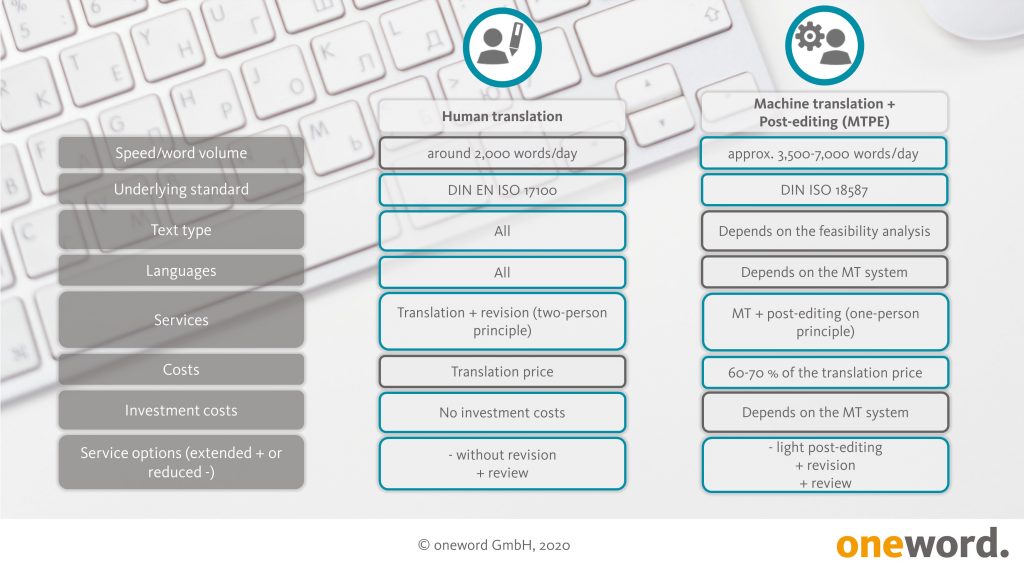17/06/2021
What’s the difference between human translation and MTPE?
Machine translation + post-editing (MTPE) offers several advantages by combining machine pre-translation and human post-editing. But how exactly does this method differ from pure human translation? Let us explain.
In our blog post “What is MTPE?” we explained that MTPE consists of a learning algorithm (an area of artificial intelligence) and professional post-editing by a trained linguist.
For many years, machine translation was associated with gaps in quality, producing results that were more entertaining than actually usable. Translations from English to German meaning “God store the queen” instead of “God save the queen” were not uncommon.
Even the combined MTPE method still has to battle with these preconceptions. We compare MTPE to human translation in the five most important criteria and show that the choice of method doesn’t depend on quality requirements, but on individual language, text and time requirements.

The differences between MTPE and human translation at a glance © oneword GmbH.
1. The translation machine
MTPE has a component that’s not included in pure human translation: a translation machine. At the moment, it’s usually based on a neural network. Depending on the client’s budget and translation volume, this can be trained specifically for the company. The advantage is that this yields better translation results in different language combinations. In addition, trained machines – as opposed to untrained ones – can adhere to specific terminology specifications and take the company’s own language into account during translation. This reduces the effort required for subsequent post-editing. But even an untrained translation machine can speed up the translation process considerably.
2. The text type
Human translations are possible for any type of text. In principle, MTPE doesn’t exclude any type of text either. Nevertheless, the basic principles and requirements of each text have an individual effect on the success of the translation.
As a general guide, we can say that the simpler and more consistent the source text, the more successful MTPE is. Technical texts and flowing texts can be translated better than slogans or texts that have strict requirements when created (e.g. concerning special formulations). However, MTPE can also be used for official documents and marketing texts.
The first step in an MTPE order is therefore always an individual feasibility analysis, which checks whether the individual translation requirement can be met with MTPE without losing sight of the desired economic efficiency.
3. Speed
While a human linguist translates about 2000 words per day, MTPE allows, in a best-case scenario, more than double that amount. The combined method provides between 3500 and 7000 translated words per day. Existing translations also help to increase the translation speed. In this case, linguists use existing texts from the translation memory system (TM) and only translate new passages using machine translation (MT).
4. Quality of the text
Contrary to many fears, just because MTPE is faster, doesn’t mean that quality is lost. Ideally, human translations must meet the DIN EN ISO 17100 quality standard. This makes a revision process mandatory (two-person principle). MTPE, on the other hand, is based on DIN ISO 18587, where a linguist does the post-editing. A revision is not absolutely necessary in this process (one-person principle). This is why the scope of services differs: the certification of both types of translation nevertheless guarantees that even MTPE-translated texts have the same level of quality of a human translation. However, if you want to assure the quality of the texts translated with MTPE even further, you can order an optional revision.
5. Costs
Because there is less translation effort required, the cost of MTPE is significantly lower than human translations. You can make savings of between 20 and 40 percent on the translation price, as our cooperation with the global corporation HELLA has shown. An additional revision and/or review will of course increase the translation price again.
Investing in a trained translation engine is even more worthwhile, as savings of up to 50 percent are possible. However, sometimes there are high investment costs associated with having your own machine. Yet trained machines are the best solution for non-European languages or extensive terminology requirements in particular.
Conclusion: MTPE or traditional human translation?
MTPE or traditional human translation? Your translation requirements determine which method is better suited to your needs. For example, if you have enough time, if your texts are very technical or if you need to translate creative slogans, you should hire a human translator. Urgent technical descriptions from German into English, on the other hand, can be translated with MTPE in a way that saves resources and suits your business.
Would you like to find out whether you too can complete your translation projects faster and more cost-effectively with MTPE? Our free “Are you ready for MTPE?” checklist (only available in German) gives you an overview!
8 good reasons to choose oneword.
Learn more about what we do and what sets us apart from traditional translation agencies.
We explain 8 good reasons and more to choose oneword for a successful partnership.
